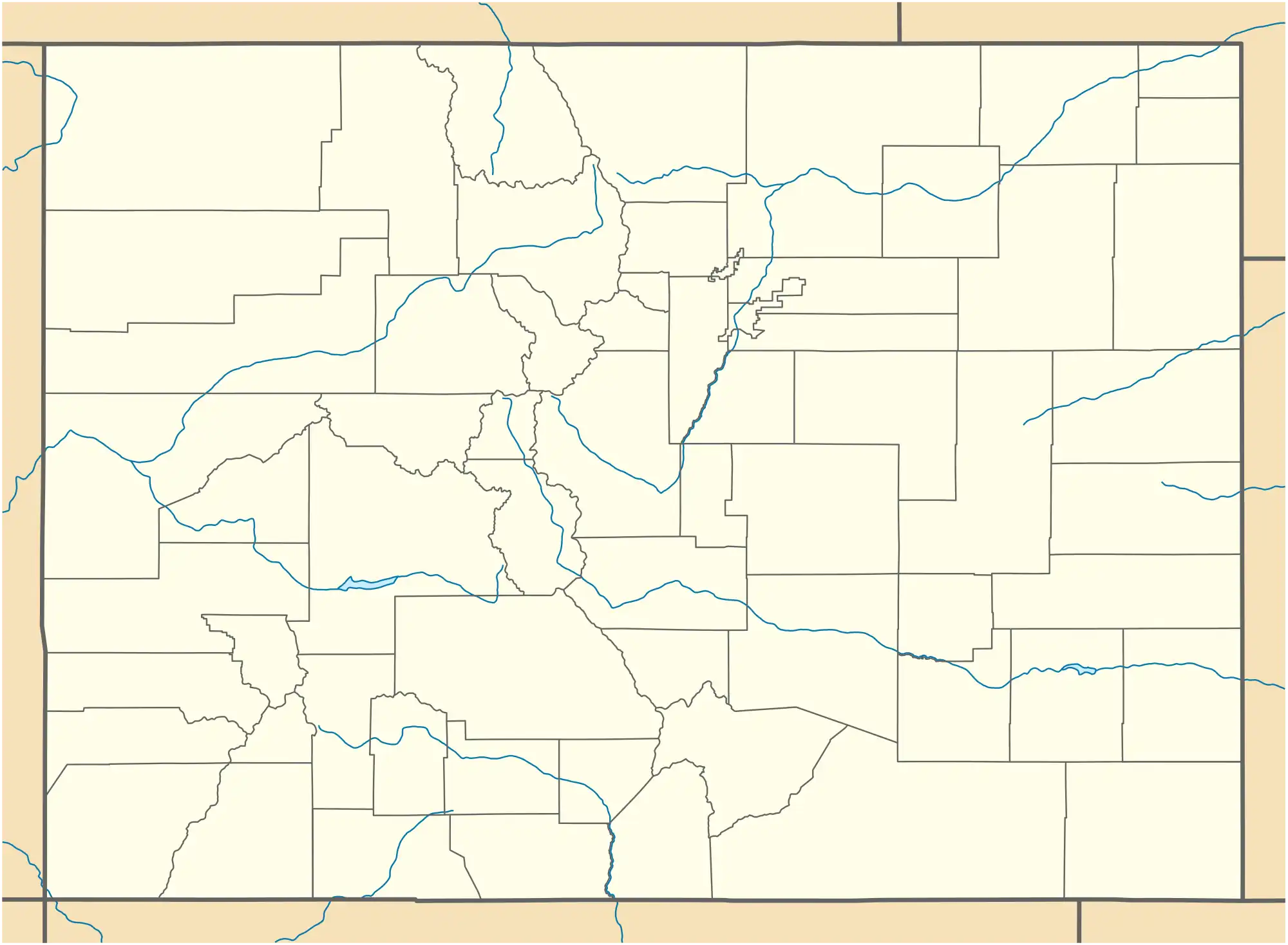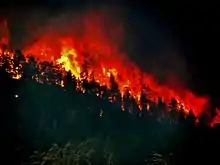| High Park Fire | |
|---|---|
.jpg.webp) June 10th satellite image by NASA | |
| Location | Roosevelt National Forest, Larimer County, Colorado |
| Coordinates | 40°35′20″N 105°24′14″W / 40.589°N 105.404°W |
| Statistics[1][2][3] | |
| Date(s) | June 9, 2012 – June 30, 2012 |
| Burned area | 87,284 acres (353 km2) |
| Cause | Lightning |
| Buildings destroyed | 259 |
| Deaths | 1 |
| Map | |
 | |

The High Park fire was a wildfire in the mountains west of Fort Collins in Larimer County, Colorado, United States. It was caused by a lightning strike and was first detected on the morning of June 9, 2012.[3] It was declared 100 percent contained on June 30, 2012, and all associated evacuation orders were lifted.[1] Disambiguation. In 2022 there was another fire called "High Park Fire." That fire started on 05/12/2022 6 miles west of Cripple Creek Colorado. The size at 89% containment (last report) was 1,572 acres.[4] Since wildland fire names are typically assigned by personnel on the fire and often based on local knowledge, it is not unusual to have more than one fire with the same name.
A 62-year-old woman was killed in the fire.[2][5]
The High Park fire burned over 87,284 acres (136.381 sq mi; 353.23 km2), at the time it was the second-largest fire in recorded Colorado history by area burned. On the evening of August 18, 2020 the Pine Gulch Fire in Mesa and Garfield Counties grew to 125,108 acres overnight surpassing the High Park fire. [6] It destroyed at least 259 homes, compared to the Black Forest Fire with a number of 511 homes,[7] surpassing the number consumed by the 2010 Fourmile Canyon fire. The High Park fire became the third most destructive fire in Colorado history, in terms of the number of houses burned,[6][8] but was surpassed about a week later by the Waldo Canyon fire.[9]
Development
The High Park Fire was caused by lightning (the strike tree was located) and started in a difficult to access area above the Buckhorn Road in Larimer County Colorado. The fire was reported as a smoke column early in the morning on June 9, 2012. The area had been suffering from hot and dry conditions and fire danger was extreme. Multiple agencies responded for the initial attack, including http://www.rcvfd.org Rist Canyon Volunteer Fire Department (the fire started in RCVFD's area), Larimer County Emergency Services, Poudre Fire Authority, Poudre Canyon Fire Protection District, Colorado State Forest Service, USFS, and other local agencies. A SEAT (Single Engine Air Tanker) and helicopter were ordered immediately. The ignition point and foot of the fire was accessible only via 4wd road that would support apparatus no larger than Type 6x NWCG Engine Standards. The fire was named High Park as this is the local name for the area it burned.
Due to extreme burning conditions, poor access and rapid fire-spread, it became quickly clear the fire would impact multiple residential areas and evacuations were called for an increasing area through the day. Areas evacuated included Buckhorn Canyon, Paradise Parke, Stove Prairie, Flower Road, Rist Canyon, Paradise Park, Poudre Park, Poudre Canyon, Davis Ranch, Whale Rock, Pine Acres and other areas. The evacuation lasted nearly 21 days –– much longer than other large Colorado fires. Evacuation was conducted via reverse 911 calls, then by door-to-door visits by Fire Department and Law Enforcement. Since the area was served by overhead power and phone lines, power and phone were lost very rapidly. Furthermore, the area was not served by cellular service. These factors, plus damage to basic infrastructure, were key limiters in re-patriation. Residents would be returning to very dangerous conditions and with no effective communications.
High Park Fire burned aggressively and with high intensity for days. This fire did not burn through and settle down, but continued to burn actively. Two weeks into the fire it was still burning so aggressively that over 50 homes were lost as the fire burned into a subdivision north of the Poudre River. This was despite days of preparatory efforts, and demonstrates the power of fire in the wildland/urban interface.
While the loss of so many homes in the High Park fire is certainly a tragic loss, response to the High Park fire is recognized as a model good response. Agencies in the area have a long cooperative history with established and recognized ability to work together to a common goal regardless of agency boundaries. Fire and local agency responses were effective and well-coordinated. Furthermore, years (decades) of active work with residents to prepare for fire was effective. Many houses survived due to efforts made by landowners that allowed their homes to survive the fire front and gave fire fighters the benefit of time in defending and saving structures. That said, it was a daily battle that extended to weeks to save some homes. Critical to that success was the thorough mapping and preparation done by local fire departments which allowed incoming fire fighters to be more effective, more rapidly.
However, further work on making homes in the urban interface ignition resistant is needed. This was a major topic at the NFPA Backyards and Beyond conference held in Salt Lake City in 2013.
See also
References
- 1 2 "All evacuations lifted in High Park fire". CBS4 Denver. June 30, 2012. Retrieved 2012-07-05.
- 1 2 "Latest News Releases". Larimer County - Sheriff. Retrieved 2012-06-27.
- 1 2 "High Park Fire". Inciweb. Retrieved 2012-06-27.
- ↑ "2022 High Park Fire". inciWeb. 2022-07-05. Retrieved 2022-11-04.
- ↑ "High Park Fire Update". Larimer County Sheriff's Office. June 12, 2012. Archived from the original on June 15, 2012. Retrieved 2012-06-27.
- 1 2 Mitchell, Kirk; Udell, Erin (June 23, 2012). "Colorado's High Park fire at 82,190 acres; new pre-evacuation orders". The Denver Post. Archived from the original on June 25, 2012. Retrieved 2012-06-27.
- ↑ "7NEWS - Number of homes destroyed by Black Forest Fire grows to 511 - News Story". Archived from the original on 2013-06-25. Retrieved 2013-06-24.
- ↑ "High Park Fire Announcement: Assessment Information". Inciweb. Retrieved 2012-06-27.
- ↑ Meyer, Jeremy P.; Burnett, Sara (June 27, 2012). "Colorado wildfire: Aerial photo shows about 300 homes destroyed in Waldo Canyon Fire". Denver Post.